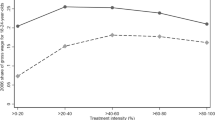Abstract
Evidence is accumulating which suggests that public employee pay levels may contain substantial rent components. The purpose of this study is twofold: to relate the theories of public choice and competitive rent seeking to this evidence and to improve upon existing estimates of rent levels by incorporating the effects of fringe benefits and stability of employment. This study concludes that once nonwage forms of compensation are included, economic rents are contained in pay levels at all three levels of government for both sexes.
Similar content being viewed by others
References
Bellante, Don and Jackson, Mark,Labor Economics: Choice in Labor Markets, New York, 1979.
Bloch, Farrell, and Smith, Sharon, “Human Capital and Labor Market Employment,”Journal of Human Resources, 12 Fall 1977, pp. 550–60.
Bush, Winston, and Denzau, Arthur, “The Voting Behavior of Bureaucrats and Public Sector Growth,” inBudgets and Bureaucrats (Borcherding, T., ed.) Durham, 1977.
Cohany, H. P., and Dewey, L. M., “Union Membership Among Government Employees,”Monthly Labor Review, 93 July 1970, pp. 15–20.
Downs, Anthony,An Economic Theory of Democracy, New York, 1957.
Fogel, Walter, and Lewin, David, “Wage Determination in the Public Sector,”Industrial and Labor Relations Review, 27 April 1974, pp. 410–31.
Freeman, Richard,The Overeducated American, New York, 1976.
Friend, Edward,First National Survey of Employee Benefits of Full-Time personnel of U.S. Municipalities, Washington, D.C.: Labor Management Relations Service, 1972.
Gerhart, Paul, “The Effect of Government Ownership on Union Wages: Comments,” inLabor in the Public and Nonprofit Sectors (Hamermesh, D. S., ed.) Princeton, 1975.
Gwartney, James, and Silberman, Jon, “Distribution of Costs and Benefits and the Significance of Collective Decision Rules,”Social Science Quarterly, 54 December 1973, pp. 568–78.
Hamermesh, Daniel, “The Effect of Government Ownership on Union Wages,” inLabor in the Public and Nonprofit Sectors (Hamermesh, D. S., ed.) Princeton, 1975.
Krueger, Anne, “The Political Economy of the Rent-Seeking Society,”American Economic Review, 64 June 1974, pp. 291–303.
Pascal, Anthony, “The Hidden Costs of Collective Bargaining in Local Government,”Taxing and Spending, 3 Spring 1980, pp. 31–40.
Posner, Richard, “The Social Costs of Monopoly and Regulation,”Journal of Political Economy, 83 August 1975, pp. 807–27.
Quinn, Joseph, “Wage Differences among Older Workers in the Public and Private Sectors,”Journal of Human Resources, 14 Winter 1979, pp. 41–62.
Reder, Melvin, “The Theory of Employment and Wages in the Public Sector,” inLabor in the Public and Nonprofit Sectors (Hamermesh, D. S., ed.) Princeton, 1975.
Smith, Sharon, “Pay Differentials between Federal Government and Private Sector Workers,”Industrial and Labor Relations Review, 29 January 1976a, pp. 179–97.
_____, “Government Wage Differentials by Sex,”Journal of Human Resources, 11 Spring 1976b, pp. 185–99.
_____,Equal Pay in the Public Sector: Fact or Fantasy? Princeton, N.J.: Industrial Relations Section 1977a.
_____, “Government Wage Differentials,”Journal of Urban Economics, 4 July 1977b, pp. 248–71.
Tullock, Gordon,Toward a Mathematics of Politics, Ann Arbor: University of Michigan Press 1967.
_____, “The Welfare Costs of Tariffs, Monopolies, and Theft,”Western Economic Journal, 5 June 1967, pp. 224–32.
_____, “The Transitional Gains Trap,”Bell Journal of Economics, 6 Autumn 1975, pp. 671–78.
UCLA Law School, “Collective Bargaining and Politics in Public Employment,”UCLA Law Review, 19 August 1972, pp. 887–1051.
U.S. Civil Service Commission,Union Recognition in the Federal Government, Washington 1978.
U.S. Dept. of Commerce, Bureau of the Census, Census of Population, Final Reports,Government Workers, Washington, 1973.
_____,Labor-management Relations in State and Local Government, Washington, 1979.
U.S. Dept. of Labor, Bureau of Labor Statistics,State Government Employee Compensation 1972, Washington, 1976.
U.S. General Accounting Office,Report to the Congress, Need for a Comparability Policy for Both Pay and Benefits of Federal Civilian Employees, Washington, 1975.
Wall Street Journal, “Labor Letter,” June 20, 1978a, p. 1.
_____, “Half a Loaf,” June 27, 1978b, p. 22
Author information
Authors and Affiliations
Additional information
The authors wish to acknowledge their immense debt to Sharon Smith, who provided us with much of the data used in this study. The assistance of Betsy Rankin is also gratefully acknowledged. The authors alone, however, are responsible for the contents of this article.
Rights and permissions
About this article
Cite this article
Bellante, D., Long, J. The political economy of the rent-seeking society: The case of public employees and their unions. Journal of Labor Research 2, 1–14 (1981). https://doi.org/10.1007/BF02685118
Issue Date:
DOI: https://doi.org/10.1007/BF02685118




